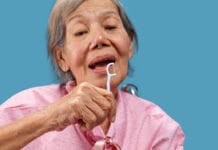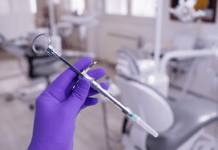Taking a walk down the dental aisle in any retail store can be slightly overwhelming. The selection of dental products is rich. Among that selection exist a multitude of toothbrushes. Toothbrushes have evolved into technologically advanced gadgets that some may contemplate the effectiveness or the need.
A routine visit to your dental office can often lead to a recommendation for a power-driven brush. However, the dental hygienist will likely give you a manual toothbrush as a parting gift upon your dismissal. Many patients admit that they never buy a brush and essentially rely on their free brush every six months, despite the recommendation of replacement every three months. What many are left wondering is if the investment is worth all the buzz.
Optimal plaque removal is essential to the health of the periodontium and reduction in decay. Brushing, in general, is key in achieving a healthy mouth and can be done using a variety of toothbrushes available on the market. Whether it be electric or manual, the overall effectiveness relies on how thorough the patient is during a given brushing session. The recommended brushing time is 2 minutes with most people averaging around 45-70 seconds.[1] On average, the human hand can achieve 200-400 brush strokes per minute using a manual brush properly. While impressive, it pales in comparison to how many strokes an electric brush can produce. Rotating-oscillating brushes achieve up to 8,000 strokes per minute and a sonic brush averages 30,000 strokes a minute![2]
In addition to the notable brush strokes per minute, electric brushes also bring a lot more to the table. Most electric brushes have timers that ensure one is brushing the full recommended two minutes. Some even alert the user when to move to a different section of the mouth so that every quadrant is given equal time. Electric brushes are also equipped with adjustable power levels to satisfy even the most sensitive of people. Because aggressive brushing is an ongoing battle with patients, many electric brushes incorporate sensors to detect “heavy hands” and either warn the user or slow the brush down to help reduce damage to the oral dentition. Some electric brush companies will even auto-ship your brush heads every three months to your front door.
Electronic or power-driven brushes come in a variety of forms:
- Rotating
- Rotating-oscillating
- Pulsing-electric
- Sonic and Ultrasonic
- Ionic
- Dual Head
Each of these brushes is designed to bring a different concept to the table, however, rotating and sonic brushes are the most widely used. Rotating brushes consists of small round heads that whirl in a circular motion and then oscillate in the opposite direction (think oscillating fan.) Sonic/ultrasonic brushes vibrate at very high frequencies and speeds to disrupt plaque.
While electric brushes have no limitations, they serve a great purpose for those with dexterity issues, are certainly wonderful for children who lack proper motor skills, and orthodontic patients who have lots of hardware to clean. Because of the wider bulkier handle on electric brushes, it makes the brush easier to grasp, thus, assisting the population that lacks grip strength.
Electric brushes take the “guesswork” out of brushing and can be extremely helpful for those who need extra assistance. One study proved that people who use electric brushes tend to brush in a more focused and concentrated pattern than those brushing with a manual.[3]Another study went on to prove that in just three months those using an electric brush routinely had a 20% plaque reduction and an 11% gingivitis reduction.[4]
In reality, just simply bushing is what is important to achieve optimal oral health. Whether using a manual or electric brush essentially boils down to technique and thoroughness of the user. Electric brushes will easily help achieve these goals by doing most of the work for you. One way of looking at this comparison is to remember that you can mix a cake by hand, but using an electric mixer certainly enhances the experience.
References
- Kaiser, M. How Long Does the Average Person Brush? Check out This Infographic. DentistryIQ. 30 Sept. 2014. Retrieved from www.dentistryiq.com/articles/2014/09/how-long-does-the-average-person-brush.html
- The Impressive Brush Stroke Capability of Electric Toothbrushes. Toothbrush Best. Retrieved from www.toothbrushbest.com/brush-stroke-capability/
- Hovliaras, C., et al. Dental Hygienists’ Evaluation of the Usability Research Study of the Colgate ProClinical A1500 Electric Toothbrush. The Journal of Clinical Dentistry, U.S. National Library of Medicine. 2015. Retrieved from www.ncbi.nlm.nih.gov/pubmed/26054186
- Yaacob, M., Worthington, H.V., Deacon, S.A., Deery, C. Walmsley, A.D., Robinson, P.G., Glenny, A.M. Powered versus manual toothbrushing for oral health. Cochrane Database of Systematic Reviews. 2014, Issue 6. Art. No.: CD00281. DOI: 10.1002/14651858.CD002281.pub3. Retrieved from https://www.cochranelibrary.com/cdsr/doi/10.1002/14651858.CD002281.pub3/full
[i] Kaiser, Meg. “How Long Does the Average Person Brush? Check out This Infographic.” DentistryIQ, 30 Sept. 2014, www.dentistryiq.com/articles/2014/09/how-long-does-the-average-person-brush.html.
[ii] “The Impressive Brush Stroke Capability of Electric Toothbrushes.” Tootbrush Best, www.toothbrushbest.com/brush-stroke-capability/.
[iii] Hovliaras, Christine, et al. “Dental Hygienists’ Evaluation of the Usability Research Study of the Colgate ProClinical A1500 Electric Toothbrush.” The Journal of Clinical Dentistry, U.S. National Library of Medicine, 2015, www.ncbi.nlm.nih.gov/pubmed/26054186.
[iv] Yaacob M, Worthington HV, Deacon SA, Deery C, Walmsley AD, Robinson PG, Glenny AM. Powered versus manual toothbrushing for oral health. Cochrane Database of Systematic Reviews 2014, Issue 6. Art. No.: CD002281. DOI: 10.1002/14651858.CD002281.pub3.











